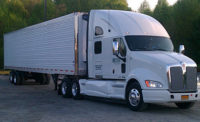Chillers account for 60% of global spending on truck refrigeration units, according to a study released by Fact.MR, Rockville, Md.
According to the study, nearly 97,969 truck refrigeration units were sold in 2018, with sales likely to expand 1.5 times from 2019-2029. In fact, the use of truck refrigeration units for the transportation of fruits and vegetables will account for nearly 40% of the overall sales through 2029.
The study opines that the demand for highly perishable foods continues to expand at an unprecedented pace, which in turn continues to hard press food and beverage companies to strengthen their product cold supply logistics/chain. This leads to an increased demand for proper transportation refrigeration infrastructure, while creating a window of opportunities for market players.
In light of the dire need for the proper and safe transportation of highly temperature-sensitive products, such as fruits and vegetables, meat, seafood and dairy products, among others, chillers witness a significant demand over freezers. The growing agriculture sector, specifically in countries like India, is further underpinning the adoption of chillers, which the study estimates is likely to exhibit the incremental opportunity of $510 million between 2019-2029. The demand for chillers is primarily driven by the rapidly growing global meat production, which is anticipated to be 16% higher in next the 5 years. As per the study, higher meat and seafood production will create an increased demand for refrigeration transportation, which in turn is projected to create innumerable opportunities for market players in the forthcoming years.
Growing attractiveness of light duty truck
The study indicates that the light duty vehicles will continue to remain the bedrock of sales for truck refrigeration units, owing to the increasing demand for smaller size vehicles for in-city product transportation. As per the analysis, light-duty vehicles accounted for about 46% market volume share in 2018, with sales likely to reach 46,862 units in 2019. As per the study, this steady growth in the adoption of lightweight-duty vehicles falls in line with the rising population, coupled with smaller lane size, specifically in developing regions. Though the demand for lightweight-duty vehicles continues to pick up the pace, the medium-size trucks are also estimated to grow at volume CAGR of 4.4% during the foreseeable period.
Furthermore, automakers are increasingly developing electric vehicles to significantly emissions. In view of this shift in development and preference, a large number of manufacturers of truck refrigeration units are focusing on electric variants. Moreover, as per the analysis, the adoption of vehicle-powered truck refrigeration units continues to grow at a steady pace, whereas high-cost diesel-powered variants are increasingly losing their attractiveness. The adoption of vehicle powered truck refrigeration units reached 61,129 units in 2018, and is likely to account for 60% market share in 2019.
Steady market growth ahead in developing regions
The study indicates that the rapidly proliferating agriculture sector in developing regions creates an increased demand for proper transportation of temperature-sensitive fruits and vegetables. As per the study, the fruits and vegetables sector is to remain a considerable mine of opportunities for stakeholders looking forward to expanding their business and extending their reach in the rapidly developing regions. In East Asia, for example, China is projected to be the most attractive country through 2029, and accounted for 70% regional market share in 2018.
The traction for truck refrigeration units continues to pick pace in line with the rapidly growing cold chain industry and increasing demand for quality-ensuring packaged foods. Additionally, truck refrigeration units are also witnessing wide adoption for the accelerating applications in the pharmaceuticals industry, which in turn continues to promise lucrative growth opportunities for truck refrigeration units market in the future.



